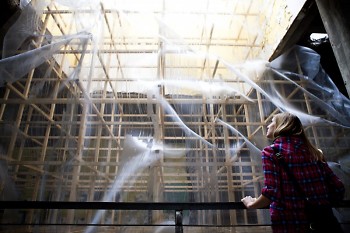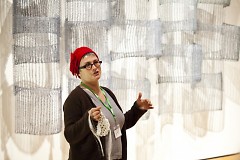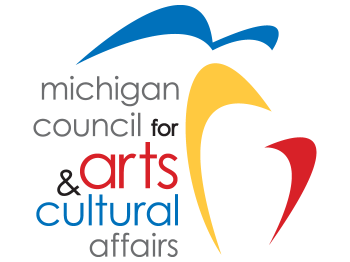At a panel discussion last Friday at GVSU, ArtPrize artist Cynthia McKean defended the moose-o-nails that made headlines in 2009: “It was so real, you could almost touch it.” Her admiration of the odd representation of moose fur wasn’t what caught my attention. It was her conclusion: “It brings people in who might be intimidated by art.”
Intimidated by art? Even the Public Museum promised “approachable art” this year, as if anything less would be offensive. What is going on? We are talking about mostly inanimate objects after all. Picture an artwork glowering over you: Understand me, or else!
When people say they are intimidated by art, I think what they mean is that the artwork is confusing. Or they don’t understand it. Or they don’t know what it means. Or they feel it is asking a question they can’t answer. In short, it does not fit into the implicit order of things. But who’s in charge of what you think? Of what you feel? The artwork? Or you?
Art that hits a single note we all understand does something we all crave: it affirms. We see. (Look!) We know what we see. (A moose!) We know that we know. (Wow. That really looks like a moose.) We go have a beer.
Works that I want to spend my time with do at least two things at once: they give me pleasure while also putting me face-to-face with my own infinite ignorance. In fact, that experience of ignorance, of wonder, even disorientation becomes pleasurable because the art offers an unexpected and enlivening way to experience the unknown. This year some works, large and small, have stopped me in my tracks by a sheer force of aesthetic presence. They took my breath away before my mind had a chance to think.
Works at Meijer Garden are especially worth mentioning since they are far-flung from the downtown ArtPrize center of gravity. The pieces have been collected and placed with care and are worth visiting for that reason alone. Mari Andrew’s ever-so-slight piece called Helium, a piece so small you might miss it, is simple, innocent, and sad all at once. It hangs casting its pencil-like shadow on the wall, its frail little nest suspended. Is it approachable? Intimidating? Helium renders the question irrelevant.
Yvette Kaiser Smith’s Etudes from Pi in 5 Squared also casts its own drawing-like shadow on the wall: the fiberglass squares crocheted and hung in a basketweave pattern are pleasing in their balanced irregularity. The artist had some very interesting things to say about her process, how she wanted to abstract identity (whatever that means), how she works furiously and then encounters a new insight every three years, how she uses pi to make a truly random pattern. But really, it just grabbed me by the lapels. So did Barbara Cooper’s Peel. And Dana Freeman’s Landscape Reliquary. And Zac Ove’s Exodus. And Stephen Knapp’s Castled Void. One of the most powerful pieces at Meijer Garden is DeWitt Godfrey’s Buttress: a pile of steel cylinders that look as if they have just tumbled down the hill, like a pile of paper rolls, to find their angle of repose. The twist on scale and material drive the viewer to see and experience the pond in the distance, the migrating egrets, the cloud cover in a new way. Like Wallace Steven’s jar makes a slovenly wilderness on the hill in Tennessee, a cascade of drooping steel makes the garden something more.
If there were a collective award for the greatest use of space it should go to Site Lab at the corner of Fulton and Division. Each piece worked like hell. The dilapidated, cavernous space throws the viewer off balance. Each artist responded to this as if responding to a question, and each piece made beauty out of its little corner of chaos. Is there a better metaphor for our moment? David Bowen’s Tele-present Water plays wave data from a lost buoy in the Pacific like sheet music, bringing together the locatedness and lostness, the organic and the mechanical. Alois Kronshlaeger’s Spire juts through three floors of urban deterioration as if it were staving off collapse. Shinji Turner-Yamamoto’s Disappearences—An Eternal Journey goes on and on and on in a stunning arrangement of brokenness. Meghan Reynard’s arresting Apparition thrusts light through nearly complete darkness. Each of these works had an effect on the body—it brought back art out of the airless cognitive ozone and back where it belongs—in your pulse.
Are these works intimidating? Approachable? Accessible? They may ask something of you, but you don’t need to have an answer. Good art returns the power of interpretation to where it belongs: you.
Don’t give it up.
The Rapidian, a program of the 501(c)3 nonprofit Community Media Center, relies on the community’s support to help cover the cost of training reporters and publishing content.
We need your help.
If each of our readers and content creators who values this community platform help support its creation and maintenance, The Rapidian can continue to educate and facilitate a conversation around issues for years to come.
Please support The Rapidian and make a contribution today.




Comments
Unfortunately the majority of art entered in artprize is dumbed down, kitsch, or panders to patriotism and religion that in turn does as much un-education as education to the masses. By rewarding work that is a one liner like the moose of nails, it gives the public a false sense of what criteria real art should possess or at least art that should receive the amount of cash rewarded to it. Perhaps if the awards were spread out to effect 100-1000 artists it would nurture the artists who deserve recognition for their endeavors and cut down on work that is just motivated by the big cash prize. No other distinguished art competition comes close to the cash artprize awards, so shouldn't we make sure that the art is just as credible or better than other competitions?
I think the market nature of the cash prize is a real tension for ArtPrize. There have been at least three works this year that are selling themselves (the vending machine at UICA, the art objects for sale in the Women's Club, the guy trying to earn back his MFA tuition). Are these ironic commentaries? Or are they part of an impossible equation? The worst is when artists treat previous results as a kind of focus group and target their work to affirm the mild-mannered Christian audience. Water and Jesus anyone?
At the same time, we can't let the they-don't-know-better argument win. The real test is how articulate we can be about the art. How can we experience it and respond to it? If we didn't live in a democracy, if we weren't suffering through one of the most divided moments in civic discourse, if this were not a democratic competition, then you would be right. We could return to noblesse oblige and let the aristocrats lead. But I think the stakes are higher. If we can't elevate the discourse here--around art--how can we possible elevate it to solve our real problems?
People need to let themselves experience the art. You don't need credentials to have an aesthetic experience. I think that the gravitation toward the movie art or, worse, the self-satisfied and self-righteous art, is not about stupidity. It's something else, and it's not intractable.
Very well articulated Mara.
I guess it will always be difficult for me to shed my "elitist" attitudes about what is art...and I am not being sarcastic. Because I have spent my whole life perfecting my visual communication skills and have been a part of this artistic community since 1983, I take this all too seriously for my own mental health. I cringed last night at UICA to see all the artprize merchandise, an artist promoting his artwork made of rubber bands, and the slick corporate look of the once alternative space. There was a vital rich community of artists here before artprize without a lot of attention given to it, and then a wealthy family swoops in to capitalize on it, put their name all over it, and cash in on all the goodwill that has come of it.
As you point out the polarization in politics, I hate too that the event has polarized the local arts community. The first year of artprize every artist I knew participated, now I know only a handful of local artists exhibit. There is something to that, something in the grey in between area, and I think it is because what we have let this event become. It is a circus and no amount of spin or paid critics can change that. Maybe if there was thoughtful dialog like this in the local press and people visited and supported our arts organizations year round then I would believe there was some education about contemporary art happening here. I guess you just cant drop a hip event in a town of conservative, religious, and segregated public and expect it to rival any other established art competition. As long as the community is the enlisted to dole out the cash, this problem will never find a middle ground I fear, you will have schlock and high art and if you watch TV these days, you will know what will win out.
I appreciate you positive attitude Mara but we don't live in a real democracy and ArtPrize has nothing to do with being democratic. Do the ArtPrize borders extended into the Black or Hispanic sections of town? How many venues in the border are owned by people of color or by women? ArtPrize isn't a "radically open" competition. It's a competition where the work is selected by each venue.
The debate whether the aesthetic experience is an autonomous event or one influenced by history and beliefs has been alive and well since the days of Kant. I don't think the prize money is the tension, it's the voting. You can only be articulate about art if you are articulate about art. You don't just wake up on day being able to do that. It takes a lot of work, study, time and interest. You, Michael, me and many others have spent a lot of time, money and effort learning about art and trying to be articulate about it. ArtPrize says none of that matters. They say all you have to do is vote for what you like. That's the problem.
These are really important perspectives to bring into the conversation. The racial issues in this town are shameful and they extend well beyond the ArtPrize. The relationship between cash and art has always been fraught and takes on a new dimension here. And I would hope that you and others like you continue to make sure these views get out there. By commenting here and having conversations with others, you are elevating the conversation. And elevating the good art.
There's no easy rubber-stamp approval of ArtPrize. Cash, the privileged class, and art are in an incredibly complicated relationship. Art needs to be created independent of these things, and yet, we live in a world where value is most efficiently conferred by the pricetag and by cultural approval, whatever that means. Of course it's stupid. But these elements can't be excised from the process. They have to be dealt with, criticized, argued, articulated.
I am still holding out a hope that the more art, the more people see art, the more they will develop the skills to be a more intelligent and sophisticated viewer. And that over time, the art, and the ability to talk about it (and other things) will improve. But time will tell. If the money remains the centerpoint, it won't work. If we give up our responsibility to be articulate, it won't work. As you both acknowledge, you can't just throw a bunch of money at something and expect it to invigorate the conversation. It's the back and forth that we are having here that gives us the chance to articulate and celebrate the good. But for our views to have any traction, we have to say *why* it is good. We have to be articulate. We can't just claim we know better. That's the only way the conversation can (at least potentially) include everyone and broaden and deepen everyone's understanding.
I just wanted to share my gratitude to each of you for contributing to a vital, incisive discourse around this unwieldy subject...but most of all I wanted to thank you, Mara, for a really well-written, much-needed article. I can't tell you what it means to me that folks like you are willing to invest themselves in the difficult process of forming clear thoughts and language around this stuff...meeting our critical need for critical dialogue.
Thank you so much for reading and for your comment, Brett. I would love to read something from you on these issues.
I also share Brett's gratitutde for your contribution but I can't help but feel a undercurrent to your attitude that it's the artist or the art that isn't doing enough or that we are at fault somehow for something.
I'm interested in where this seed of an elitists attitude about art began in our society. I think it has it's roots in Modernism but gained a real foot hold during the political culture war against the NEA in the 1980's. Today we see it locally in the ridiculous commentary in places like Mlive's coverage of ArtPrize but even Mara's writing has an almost apologetic tone. Why does art have to include everyone? Is the role of a Museum to broaden eveyone's understaning of art? Even the people who don't think about attending?
I think her point is not that artists should make art accessible to everyone. Rather it's something like that to be intimidated by art is not the fault of the art, but the viewer. There's nothing actually intimidating about art, even in it's most abstract or conceptual forms. Those works may put more questions to us, the viewers—in contrast to some pieces that ask no questions but simply offer easy answers (including some political art that thinks it is "questioning" when really it's only sloganeering). Such art may expect more from us, but we should rise to the occasion, spend more time, become more articulate, and allow ourselves the chance to respond rather than being intimidated by the responsibility and moving on to something "approachable." It's not the artists' fault—that's what I take her as saying, anyway.
Frankly if were an artist with work displayed in the Public Museum I would be annoyed that the museum was advertising it's curated selection as "approachable" (even if my work were easily digestable). It suggests the museum has given up on its educational role (you can't educate without encouraging thinking), though, granted, it's not an art musuem.
Thanks, Mara: "We have to be articulate. We can't just claim we know better."
Richard, you would be the first person to call me apologetic! I absolutely am *not* arguing artists should be more accessible. I'm saying those who look at art should just relax and not freak out if they don't know what it means. Let the art work on you.
What legitimates the expert's expertise is his or her ability to explain it and share it. It's a task of conversation itself. There are certainly times, say, in the classroom, where you do what you are told because the teacher knows better. But next time, you've got to do it for yourself. There's an important role for the experts to play--namely, to show us what we might otherwise overlook. But if the experts merely condescend, no one will hear them.
I'm saying cast a wide net, but then don't be afraid of the artwork and don't be afraid of articulating what distinguishes the good from the bad. If people are truly having an aesthetic experience, the quality work will float to the top. If they are looking only to what they recognize as "good," it won't.
Regarding elitism, art has been used to wield political and religious power for a very, very long time. It's not just a contemporary or modern issue. The GR Press seems to be playing to the general anti-elitism of our moment. But unfortunately, it's celebrating simplemindedness in the process. No apology there.
Thanks, Mara, for your thoughtful posting. Your perspective is measured, explanatory and supportive of art in West Michigan.
ArtPrize, without the large cash prize, would be irrelevant. Art, on the other hand, has been a human expression since the stone age, and will continue throughout the remainder of human history—it’s what makes us human. ArtPrize does not create “better” art—it simply brings people to art.
The greatness of ArtPrize is the dialog it encourages, which can be thoughtful or obtuse. Every person is on a different art/humanities journey. Thanks for articulating what is worth seeing and why. It’s just your opinion, I know, but it reminds us all to critique the art we are experiencing. You don’t have to know much about wine to find rapture in a single glass, but to duplicate the experience and expand your taste really requires you learn more about it. It’s not an elitist point of view, it’s an enlightened point of view.
Roger, really well put.
Yes, thank you, Roger!
Very nice article Mara! Love your core concept and your thoughts about the relationship between art and its viewer. And thank you for including me!! :)